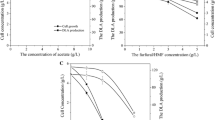Abstract
In this work, capability of Fusarium solani F-552 of producing lignocellulose-degrading enzymes in submerged fermentation was investigated. The enzyme cocktail includes hydrolases (cellulases, xylanases, and proteinases) as well as ligninolytic enzymes: manganese-dependent peroxidase (MnP), lignin peroxidase (LiP), and laccase (Lac). To our knowledge, this is the first report on production of MnP, LiP, and Lac together by one F. solani strain. The enzyme productions were significantly influenced by application of either lignocellulosic material or chemical inducers into the fermentation medium. Among them, corn bran significantly enhanced especially productions of cellulases and xylanases (248 and 170 U/mL, respectively) as compared to control culture (11.7 and 29.2 U/mL, respectively). High MnP activity (9.43 U/mL, control 0.45 U/mL) was observed when (+)-catechin was applied into the medium, the yield of LiP was maximal (33.06 U/mL, control 2.69 U/mL) in gallic acid, and Lac was efficiently induced by, 2,2′-azino-bis-[3-ethyltiazoline-6-sulfonate] (6.74 U/mL, not detected in control). Finally, in order to maximize the ligninolytic enzymes yields, a novel strategy of introduction of mild oxidative stress conditions caused by hydrogen peroxide into the fermentation broth was tested. Hydrogen peroxide significantly increased activities of MnP, LiP, and Lac which may indicate that these enzymes could be partially involved in stress response against H2O2. The concentration of H2O2 and the time of the stress application were optimized; hence, when 10 mmol/L H2O2 was applied at the second and sixth day of cultivation, the MnP, LiP, and Lac yields reached 21.67, 77.42, and 12.04 U/mL, respectively.
Similar content being viewed by others
References
Ardon O, Kerem Z, Hadar Y (1998) Enhancement of lignin degradation and laccase activity in Pleurotus ostreatus by cotton and stalk extract. Can J Microbiol 44:676–680
Arrota DS, Gill PK (2001) Comparison of two assays for lignin peroxidase. Enzyme Microb Tech 28:602–605
Bailey MJ, Biely P, Poutanen K (1992) Interlaboratory testing of methods for assay of xylanase activity. J Biotechnol 23:257–270
Dashtban M, Schraft H, Syed TA, Qin W (2010) Fungal biodegradation and enzymatic modification of lignin. Int J Biochem Mol Biol 1:36–50
Deng SP, Tabatabai MA (1994) Colorimetric determination of reducing sugar in soils. Soil Biol Biochem 26:473–477
Elisashvili V, Kachlishvili E, Penninckx M (2008) Effect of growth substrate, method of fermentation and nitrogen source on lignocellulose-degrading enzyme production by white-rot basidiomycetes. J Ind Microbiol Biotechnol 35:1531–1538
Ghose TK (1987) Measurement of cellulase activities. Pure Appl Chem 59:257–268
Hammar E, Schauer F (1997) Fungal hydroxylation of dibenzofuran. Micol Res 101:433–436
Hofrichter M, Fritsche W (1996) Depolymerization of low-rank coal by extracellular fungal enzyme systems. I. Screening for low-rank-coal-depolymerizing activities. App Microbiol Biotechnol 45:220–225
Howard RL, Abotsi E, Jansen van Rensburg EL, Howard S (2003) Lignocellulosic biotechnology: issue of bioconversion and enzyme production. Afr J Biotechnol 2:602–619
Jovanovic I, Magnuson JK, Collart F, Robbertse B, Adney WS, Himmel ME, Baker SE (2009) Fungal glycoside hydrolases for saccharification of lignocellulose: outlook for new discoveries fueled by genomics and functional studies. Cellulose 16:687–697
Kanwal HK, Reddy MS (2011) Effect of carbon, nitrogen sources and inducers on ligninolytic enzyme production by Morchella crassipes. World J Microbiol Biotechnol 27:687–691
Liu YS, Wu JY (2006) Hydrogen peroxide-induced astaxanthin biosynthesis and catalase activity in Xanthophyllomyces dendrorhous. Appl Microbiol Biotechnol 73:663–668
Lozovaya VV, Lygin AV, Zernova OV, Li S, Wildholm (2006) Lignin degradation by Fusarium solani f. sp. glycines. Plant Dis 90:77–82
Marova I, Breierova E, Koci R, Friedl Z, Slovak B, Pokorna J (2004) Influence of exogenous stress factors on production of carotenoids by some strains of carotenogenic yeasts. Ann Microbiol 54:73–85
Marova I, Carnecka M, Halienova A, Breierova E, Koci R (2010) Production of carotenoid-/ergosterol-supplemented biomass by red yeast Rhodotorula glutinis grown under external stress. Food Technol Biotechnol 48:56–61
Morita Y, Hasan Q, Sakaguchi T, Murakami Y, Yokoyama K, Tamiya E (1998) Properties of a cold-active protease from psychrotrophic Flavobacterium balustinum P104. Appl Microbiol Biotechnol 50:669–675
Obruca S, Marova I, Svoboda Z, Mikulikova R (2010) Use of controlled exogenous stress for improvement of poly(3-hydroxybutyrate) production in Cupriavidus necator. Folia Microbiol 55:17–22
Rodriguez A, Perestelo F, Carnicero A, Regalado V, Perez R, De la Fuente G, Falcon MA (1996) Degradation of natural lignins and lignocellulosis substrates by soil inhabiting fungi imperfecti. FEMS Microbiol Ecol 21:213–219
Sakaki H, Nakanishi T, Satonaka KY, Miki W, Fujita T, Komemushi S (2000) Properties of a high-torularhodin-producing mutant of Rhodotorula glutinis cultivated under oxidative stress. J Biosci Bioeng 89:203–205
Sanchez C (2009) Lignocellulosic residues: biodegradation and bioconversion by fungi. Biotechnol Adv 27:185–194
Saparrat MCN, Martinez MJ, Tournier HA, Cabello MNC, Arambarri AM (2000) Production of lignolytic enzymes by Fusarium solani strains isolated from different substrata. World J Microbiol Biotechnol 16:799–803
Spiker JK, Crawford DL, Thiel EC (1992) Oxidation of phenolic and non-phenolic substrate by the lignin peroxidase of Streptomyces viridosporus T7A. Appl Microbiol Biotechnol 37:518–523
Urzua U, Kersten PJ, Vicuna R (1998) Manganase peroxidase-dependent oxidation of glyoxylic and oxalic acids synthesized by Ceriporiopsis subvermispora produces extracellular hydrogen peroxide. Appl Environ Microbiol 64:68–73
Wei ZH, Bai L, Deng Z, Zhong JJ (2011) Enhanced production of validamycin A by H2O2-induced reactive oxygen species in fermentation of Streptomyces hygroscopicus 5008. Bioresource Technol 102:1783–1787
Acknowledgments
This work was supported by project “Centre for Materials Research at FCH BUT” No. CZ.1.05/2.1.00/01.0012 from ERDF. Financial support was realized also by Regional Innovation Strategy 3 of the City of Brno.
Author information
Authors and Affiliations
Corresponding author
Rights and permissions
About this article
Cite this article
Obruca, S., Marova, I., Matouskova, P. et al. Production of lignocellulose-degrading enzymes employing Fusarium solani F-552. Folia Microbiol 57, 221–227 (2012). https://doi.org/10.1007/s12223-012-0098-5
Received:
Accepted:
Published:
Issue Date:
DOI: https://doi.org/10.1007/s12223-012-0098-5




